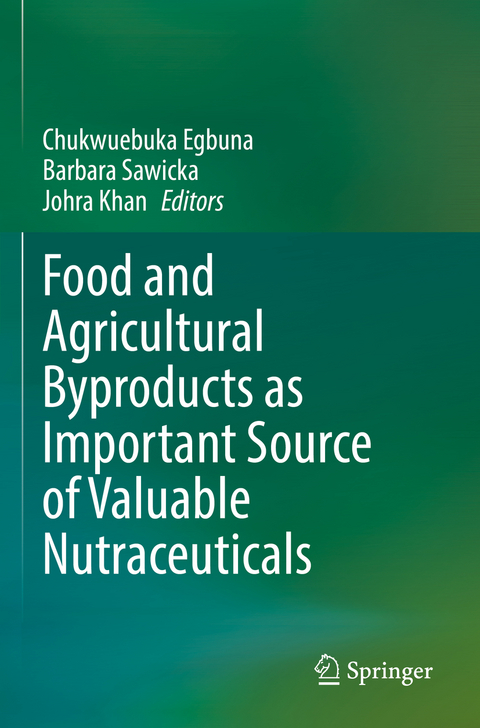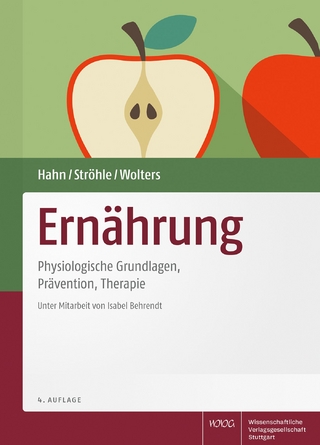
Food and Agricultural Byproducts as Important Source of Valuable Nutraceuticals
Springer International Publishing (Verlag)
978-3-030-98762-6 (ISBN)
Food and agricultural by-products are leftovers or wastes from parts of foods, fruits, vegetables and animal sources which are obtained after processing. Agricultural by-products includes peels and rinds from citrus fruits, pineapple, mango, and banana. Other notable ones are pomace from apple, olive, red beet, and those from wine making. Also, whey from milk, straws, hulls, and brans from grains are among top agricultural by-products. These by-products often impact the environment and the social-economic sectors when they are disposed. But with the recent advances in biotechnology and scientific research, scientists have found usefulness in some of these byproducts as sources of valuable nutraceuticals, a term used to refer to chemical entities present in foods that has the propensity to impact health for disease prevention and treatment. This book entitled 'Food and agricultural by-products as important source of valuable nutraceuticals' presents detailed informationabout major agricultural byproducts that are rich in nutraceuticals. The nature and the type of nutraceuticals that they contains and their health promoting benefits were presented. The editors and chapter contributors are renowned experts from key institutions around the globe. This book will be useful to students, teachers, food chemists, nutritionists, nutritional biochemists, food biotechnologists among others.
Key features
Ø Highlights the health promotion benefits of nutraceuticals
Ø Presents information on agrifood by-products as sources of nutraceuticals
Ø Discusses functional nutraceuticals from peels, rinds, pomace, hull, bran etclt;p>Chukwuebuka Egbuna
Africa Centre of Excellence in Public Health and Toxicological Research (ACE-PUTOR), University of Port-Harcourt, Rivers State, Nigeria.
Chukwuebuka Egbuna is a chartered chemist, a chemical analyst, and academic researcher. He is a member of the Institute of Chartered Chemists of Nigeria (ICCON), the Nigerian Society of Biochemistry and Molecular Biology (NSBMB), the Society of Quality Assurance (SQA) (USA), and the Royal Society of Chemistry (RSC) (United Kingdom). Egbuna is also an editor of new Elsevier series on Drug Discovery Update. The series includes books, monographs and edited collections from all areas of drug discovery, including emerging therapeutic claims for the treatment of diseases. He has also edited books with Springer Nature on functional foods and nutraceuticals and John Wiley on poisonous plants and phytochemicals. He has been engaged in a number of roles at New Divine Favor Pharmaceutical Industry Limited, Akuzor Nkpor, Anambra State, Nigeria, and Chukwuemeka Odumegwu Ojukwu University (COOU) in Nigeria. He has collaboratively worked and published quite a number of research articles in the area of phytochemistry, nutrition and toxicology and related areas. He is a reviewer and editorial board member of various journals, including serving as a website administrator for the Tropical Journal of Applied Natural Sciences (TJANS), a journal of the faculty of Natural Sciences, COOU and as an advisory board member under toxicology for the book publisher, Cambridge Scholar Publishing. His primary research interests are in phytochemistry, nutrition and toxicology, food and medicinal chemistry, and analytical biochemistry.
Barbara Sawicka
Department of Plant Production and Commodities Science, University of Life Sciences in Lublin; Akademicka street 15, 20-950 Lublin, Poland.
Professor Barbara Sawicka obtained her PhD from the Agricultural University in Lublin, Poland. Since 1999 she has been a Professor at the University of Life Science in Lublin and was promoted to Head of the Department of Plant Production Technology and Commodities Sciences in 2012. She is an honorary member of the Advisory board of Journal Archives of Agricultural and Environmental Science, a member of the advisory board of International Journal of Research & Methodology in Social Science, and also the board of STUDIA NATURAE, for the Annals Universitatis Pedagoogicae Cracoviensis. She has over 280 original research papers, 8 books and 1 patent. Her research areas of interest are Agronomy, Agribusiness and Rural Development, Bioengineering, Environmental Protection, Food Sciences, Food Safety, Commodity Products.
Johra Khan
Department of Medical Laboratory Sciences, College of Applied Medical Sciences, Majmaah University, Majmaah, 11952, Saudi Arabia.
Dr. Johra Khan, PhD is an assistant professor and principal research investigator at the College of Applied Medical Laboratory Sciences, Majmaah University, Saudi Arabia. She is a biotechnologist and academic researcher with interest in the chemistry of natural products, functional foods and nutraceuticals, analytical chemistry and studies related to both communicable and non-communicable diseases. She is a recipient of many awards and a member of many scientific bodies such as the Middle East Molecular Biology Society (MEMBS), the International Society of Global Health (ISoGH), Science Advisory Board (SAB), and the Royal Society of Biology (United Kingdom). Dr. Johra has written many articles, books and book chapters with different publishers such as Springer, CRC, IEEE, and Elsevier. She has supervised many undergraduate and postgraduate students within the last 10 years. Dr. Johra has collaborated on key research projects with scientists from different institutions including those outside of the Kingdom of Saudi Arabia. She is a reviewer and editorialChapter 1: The Role of Nutraceuticals as Food and Medicine, Types and Sources.- Chapter 2: Potato Peels as a Source of Nutraceutic.- Chapter 3: Red Beet Pomace as a Source of Nutraceuticals.- Chapter 4: Mango Peels as a Source of Nutraceuticals.- Chapter 5: Apple Pomace as a Source of Nutraceutical.- Chapter 6: Olive Pomace as a Source of Nutraceuticals.- Chapter 7: Orange Peel as a Source of Nutraceuticals.- Chapter 8: Pineapple Fruit Peels as a Source of Nutraceuticals.- Chapter 9: Jackfruit (Artocarpus heterophyllus Lam) Byproducts as a Source of Nutraceuticals.- Chapter 10: Pawpaw Peels as a Source of Nutraceuticals.- Chapter 11: Nutritional and Nutraceutical Potentials of Residual Cakes from Seeds of Moringa (Moringa oleifera L.), Sacha Inchi (Plukenetia volubilis L.) and Hibiscus Flower (Hibiscus sabdariffa L.) after Oil Extraction.- Chapter 12: Whey Protein from Milk as a Source of Nutraceuticals.- Chapter 13: Corn Byproducts as a Source of Nutraceuticals.- Chapter 14:Sorghum Byproducts as a Source of Nutraceuticals.- Chapter 15: Rice Husk as a Source of Nutraceuticals.- Chapter 16: Byproducts of Groundnut as Source of Nutraceuticals.- Chapter 17: Banana Peel as a Source of Nutraceuticals.
| Erscheinungsdatum | 15.07.2023 |
|---|---|
| Zusatzinfo | X, 257 p. 43 illus., 39 illus. in color. |
| Verlagsort | Cham |
| Sprache | englisch |
| Maße | 155 x 235 mm |
| Gewicht | 415 g |
| Themenwelt | Medizin / Pharmazie ► Gesundheitsfachberufe ► Diätassistenz / Ernährungsberatung |
| Technik ► Lebensmitteltechnologie | |
| Schlagworte | Agricultural by-products • By-products from animals • By-products from plants • By-products of agriculture • Functional Foods • Health benefits of nutraceuticals • Nutraceuticals • Nutraceuticals in peels of fruits • Nutraceuticals in pomace of fruits • Nutraceuticals in rinds of fruits • Phytochemicals • value-added by-products |
| ISBN-10 | 3-030-98762-0 / 3030987620 |
| ISBN-13 | 978-3-030-98762-6 / 9783030987626 |
| Zustand | Neuware |
| Haben Sie eine Frage zum Produkt? |
aus dem Bereich


